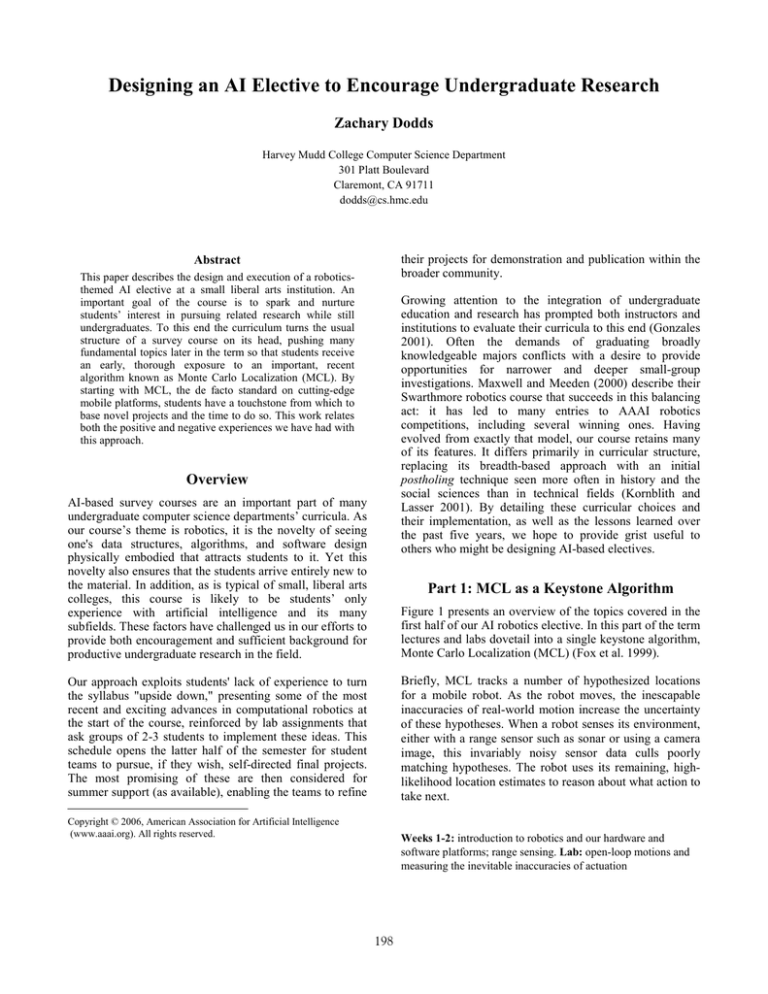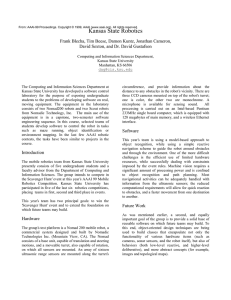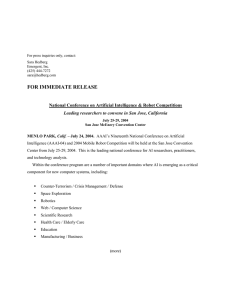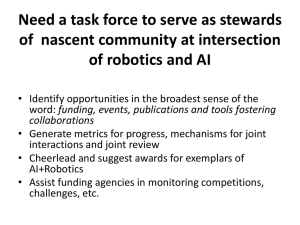
Designing an AI Elective to Encourage Undergraduate Research
Zachary Dodds
Harvey Mudd College Computer Science Department
301 Platt Boulevard
Claremont, CA 91711
dodds@cs.hmc.edu
their projects for demonstration and publication within the
broader community.
Abstract
This paper describes the design and execution of a roboticsthemed AI elective at a small liberal arts institution. An
important goal of the course is to spark and nurture
students’ interest in pursuing related research while still
undergraduates. To this end the curriculum turns the usual
structure of a survey course on its head, pushing many
fundamental topics later in the term so that students receive
an early, thorough exposure to an important, recent
algorithm known as Monte Carlo Localization (MCL). By
starting with MCL, the de facto standard on cutting-edge
mobile platforms, students have a touchstone from which to
base novel projects and the time to do so. This work relates
both the positive and negative experiences we have had with
this approach.
Growing attention to the integration of undergraduate
education and research has prompted both instructors and
institutions to evaluate their curricula to this end (Gonzales
2001). Often the demands of graduating broadly
knowledgeable majors conflicts with a desire to provide
opportunities for narrower and deeper small-group
investigations. Maxwell and Meeden (2000) describe their
Swarthmore robotics course that succeeds in this balancing
act: it has led to many entries to AAAI robotics
competitions, including several winning ones. Having
evolved from exactly that model, our course retains many
of its features. It differs primarily in curricular structure,
replacing its breadth-based approach with an initial
postholing technique seen more often in history and the
social sciences than in technical fields (Kornblith and
Lasser 2001). By detailing these curricular choices and
their implementation, as well as the lessons learned over
the past five years, we hope to provide grist useful to
others who might be designing AI-based electives.
Overview
AI-based survey courses are an important part of many
undergraduate computer science departments’ curricula. As
our course’s theme is robotics, it is the novelty of seeing
one's data structures, algorithms, and software design
physically embodied that attracts students to it. Yet this
novelty also ensures that the students arrive entirely new to
the material. In addition, as is typical of small, liberal arts
colleges, this course is likely to be students’ only
experience with artificial intelligence and its many
subfields. These factors have challenged us in our efforts to
provide both encouragement and sufficient background for
productive undergraduate research in the field.
Figure 1 presents an overview of the topics covered in the
first half of our AI robotics elective. In this part of the term
lectures and labs dovetail into a single keystone algorithm,
Monte Carlo Localization (MCL) (Fox et al. 1999).
Our approach exploits students' lack of experience to turn
the syllabus "upside down," presenting some of the most
recent and exciting advances in computational robotics at
the start of the course, reinforced by lab assignments that
ask groups of 2-3 students to implement these ideas. This
schedule opens the latter half of the semester for student
teams to pursue, if they wish, self-directed final projects.
The most promising of these are then considered for
summer support (as available), enabling the teams to refine
Briefly, MCL tracks a number of hypothesized locations
for a mobile robot. As the robot moves, the inescapable
inaccuracies of real-world motion increase the uncertainty
of these hypotheses. When a robot senses its environment,
either with a range sensor such as sonar or using a camera
image, this invariably noisy sensor data culls poorly
matching hypotheses. The robot uses its remaining, highlikelihood location estimates to reason about what action to
take next.
Part 1: MCL as a Keystone Algorithm
Copyright © 2006, American Association for Artificial Intelligence
(www.aaai.org). All rights reserved.
Weeks 1-2: introduction to robotics and our hardware and
software platforms; range sensing. Lab: open-loop motions and
measuring the inevitable inaccuracies of actuation
198
hands-on implementations. Small written assignments –
both in-class and for homework – reinforce the material
concurrent with its presentation. One advantage of this
schedule is that students see more advanced mapping and
navigation algorithms that build on MCL while they are
implementing and testing that algorithm. Again following
Maxwell and Meeden (2000), the lectures reinforce
assigned papers on evidence-grid mapping (Martin and
Moravec 1996), SLAM (simultaneous localization and
mapping) (Montemerlo et al. 2002), and the entropy-based
coastal navigation algorithm (Roy and Thrun 1999). These
techniques further highlight the breadth and utility of
probabilistic spatial reasoning. They also are intended to
suggest directions for student-based final projects, which
begin immediately after the break.
Weeks 3-4: probabilistic models of uncertainty; basics of image
processing. Lab: adding a sonar ranger to the robot, calibrating it,
and obtaining simple probabilistic models of sensor error
Weeks 5-6: Bayesian reasoning and its role underlying MCL.
Lab: basic image processing routines (color-based region
identification and shape statistics) to extract hallway landmarks
Weeks 7-8: other probabilistic robotics algorithms: SLAM,
evidence grids, and coastal navigation Lab: implementing MCL
in a provided hallway map using their motion/sensing models
Week 9: Spring break
Figure 1 An overview of the initial topics covered in our
Robotics elective. Details including lecture slides, written
assignments, supporting software and lab projects are available
online from www.cs.hmc.edu/~dodds/courses.
While simple, MCL motivates the Bayesian reasoning that
plays so central a role within current work in artificial
intelligence of all stripes. Though its basic tenets go back
centuries, MCL per se is less than a decade old; as a result,
it continues to motivate cutting-edge variations and
applications (Elinas and Little 2005, Wolf et al. 2005).
Part 2: Acknowledging Robotics’s Breadth
Because students’ lab projects diverge in the second half of
the term, the lecture content less directly supports their outof-class efforts. We try to exploit this disconnect in two
ways. First, the curriculum returns to some fundamental
robotics topics appearing earlier in more traditionally
structured syllabi, e.g., configuration space and the many
approaches to path planning within it. Figure 2 outlines
these topics. Second, student teams punctuate lecture time
with updates and demonstrations of their particular
projects’ progress. Written and programming assignments
also become more important for reinforcing the lectures’
topics, since lab work is less likely to do so. For instance,
students build a vision program that plays the game of Set
(www.setgame.com). Students’ efforts culminate in
public demonstrations of their projects on the final day of
classes. The final online write-up is posted a week
afterwards.
The process of implementing MCL frames the labs and
lectures of the first half of the semester. Building
probabilistic error models of their robots' drive systems
provides students a backdrop for learning how to use the
hardware and software in the first two weeks. Creating
complementary error models for their robots’ sensors
similarly motivates a short introduction to image
processing and the construction of a sonar ranging unit.
The integration of these models into the MCL algorithm
reinforces these early labs and results in a coherent system
that student teams can demonstrate by midterm.
Because MCL is a passive state-estimation algorithm,
students can use simple wandering routines or even
human-controlled motions to test their implementations. In
contrast, many AI-based robotics courses present
wandering or wall-following as early lab projects. Because
these behaviors depend so intimately on the environment
and sensor modalities being used, in our experience this
approach focuses students’ energies on writing code
tailored tightly to our buildings’ hallways. Although this
provides realistic robot-programming experience and is
justified by robotics’s history, we found that it did not hint
at the rapidly maturing and environment-independent basis
for current state-of-the-art systems. Probabilistic robotics
(Thrun 2002), on the other hand, puts such site-specific
effort into a context that can be applied to any specialreasoning system based on noisy inputs.
Weeks 10-11: more sophisticated computer vision algorithms,
e.g., condensation, identical in spirit to MCL Lab: first
deliverable in each student team’s final project. For the default
(fire-extinguishing) project, students build their Lego platform
and write programs to test its motor and sensor subsystems.
Weeks 12-13: optical flow and its use in estimating time-tocollision. Lab: second final-project deliverable. For the default
project, students write and test maze-wandering code.
Weeks 14-15: robots’ configuration space and several path
planning algorithms. Lab: final deliverable in each student
team’s final project, in which students are testing and tuning full,
integrated systems.
Week 16: Dedicated to finishing the lab projects, including a
term-end demonstration that can attract outsiders as well.
Figure 2 A synopsis of the second half of the elective.
Ultimately, the risks of overreaching have been the biggest
drawback of student-selected capstone projects. We feel
that the successful projects more than balance the need for
additional instructor effort. Yet the projects that do not
Integrating Labs and Lectures
In order that students feel prepared for the lab projects,
classroom lectures pace about two weeks ahead of these
199
undergraduate student research. In addition to benefiting
the student presenter, this work was folded into the lectures
of the 2005 offering of Robotics. Such feedback helped
reinforce the idea that students’ course projects could be a
jumping-off point, rather than a terminal experience in AI
and, more generally, computer science research. Different
events, such as CCSC’s and ACM-SE’s workshops, make
such opportunities available throughout the country.
succeed leave students with a sour taste for the course, if
not the whole field. Such disappointments have been most
acute when caused, in part, by limitations of the hardware
or software we have provided to the students. As a result,
we have recently offered a “default” second-half project:
building and programming a “fire-fighting” robot. This has
been demonstrated with a wide variety of controllers
including the Lego RCX, the Handy Board, and several
custom-built platforms. Inspired by the Trinity College
robot contest (Verner and Ahlgren 2002), this project has
been calibrated to provide a moderate, attainable challenge.
Working Beyond the Semester
Despite the availability of this default project, we continue
to seek out ways of encouraging students to explore
outside the safety of well-worn paths. To this end we use
external venues - and their deadlines - to motivate students
beyond the necessarily short-range schedule of a fourmonth semester. We encourage student teams to point their
work toward a particular poster, paper, or competition
submission. The following experiences highlight the
variety of venues that have provided concrete objectives
toward which our students have aimed their efforts:
Figure 3 (Top) The feature tracking and resulting visual map
anchoring the student work submitted to SIGCSE’s 2004
undergraduate student research competition (Bottom Left) A
birds’-eye view of the students’ entry to the 2004 Collegiate
Botball competition (Bottom Right) An Evolution ER1 platform
retrieving the beach ball in the 2005 AAAI robot scavenger hunt.
Educational Venues
In the spring semester of 2003, a pair of students wanted to
investigate the then-new Evolution ER1 platform.
Although difficulties with the software led to far less
progress than they had hoped, the start they made and a
continuation the following fall led to the development of a
new graphical user interface and python-based support
code for that robot. Although not robotics research per se,
this effort was presented at the following spring’s
education-themed AAAI Symposium. It also provided the
following year’s students with a better starting point for
their projects.
AAAI Robot Competition
In 2005, one of the student teams worked toward entering
the AAAI’s 14-year-old annual robot competition. These
four students started with the course’s ordinary MCL labs
through the first half of the course. In the second half,
however, they integrated behaviors such as object
identification and arrow-following (both extensions of the
Set-playing assignment) into their map-based localization
routines. In this case, summer support was available. Three
of the students used May and June to add sensors and a
second computer to their ER1 to create their competition
entry, shown in Figure 3. In July they participated in the
AAAI robot scavenger hunt and robot workshop, an
experience all four consider a highlight of their
undergraduate years.
Beyond Botball
In the spring semester of 2004, a team of five students
chose to build an entry to the Collegiate Botball
competition (Miller and Winton 2004) as their final course
project. Although we did not have summer support, three
of the students could enter their platform (Figure 3) and
attend AAAI, a collocated conference, because it was
nearby. This competition runs each summer, now under the
name Beyond Botball, under the aegis of the National
Conference for Educational Robotics.
Traditional Research Venues
The work presented at SIGCSE has led to the proposal and
study of an algorithm coined Monte Carlo Correction, a
vision-based MCL variant. Through the fall of 2005, a
student has been investigating the effects of a posecorrection step in which MCL’s particles are updated based
on the alignment of image features and their hypothesized
world locations. The result has been prepared into a
submission to a pattern-recognition research conference,
with its status still pending. Similarly, the AAAI scavenger
hunt work motivated those students to write up both the
Poster Presentations
The experience at AAAI prompted one of the students to
work during the fall of 2004 on an independent study to
extend Monte Carlo Localization in order to take
advantage of visually-mapped environments (Figure 3,
top). The student submitted his work as a poster to both a
regional site, SCCUR, and a national venue, SIGCSE, for
200
Indeed, students’ reflections on the course suggest a
realization that such challenges are an often unavoidable
part of hands-on work with robots. Reported satisfaction
levels have not varied in its five offerings. Suggestions for
improvements consistently run the gamut from “if this is a
computational course, why are we dealing with hardware
at all” to “there should be more time on the hardware – its
design, the sensors, etc.”
algorithmic (Davidson et al 2006) and engineering
(Davidson et al. 2005) details of their platform.
Regardless of the outcome for a particular paper or robot
submission, however, each of these efforts contributes to
our overall goal: integrating students’ coursework as much
as possible with the ongoing flow of AI’s educational and
research communities.
Despite the drawbacks of our course design, we believe
that five years of tinkering with its structure has helped to
create an offering that can seed and nurture undergraduate
research projects. Across that timespan, the following
choices have the most valuable in our efforts to encourage
undergraduate research through a survey course:
Results and Lessons Learned
As the above descriptions show, the results from our
offerings of Robotics vary based on many forces not
completely within our control: students’ interests, external
venues for different kinds of projects, and the funding
available for summer continuations of the semester’s work.
As expected, the course’s design has not produced only
success stories. For each of the undergraduate research
projects described in the last section, there have been more
that have foundered, e.g., a group of seniors learning that
FastSLAM was too much to completely implement as a
final project. The flexibility offered in project hardware
and scope carries substantial risks. The Evolution ER1’s
software stymied a dedicated pair of students in a fullsemester effort to get it working in 2003; similar
frustrations arose for students working with the Palm Pilot
Robot Kit (Resko et al. 2002). In 2005 both the hardware
and the software of the XPort Robot Controller, which uses
the Nintendo GameBoy Advance as its computational
engine, proved too poorly documented to support our final
fire-extinguishing task.
More detail on the experiences and substantial efforts these
student teams made toward their final projects’ goals are
documented in an archive of online write-ups available at
www.cs.hmc.edu/~dodds/projects. In all of
these cases, we feel the difficulties arise fundamentally
from the ambition of the course design. After all, the
student teams were investigating algorithms and hardware
with which the instructor was not familiar. In addition, the
variety of student-chosen projects undertaken in a class of
8-10 teams (20-24 students) yields limited instructor time
available to master the details of each one.
•
ensuring younger students are in the class
Sophomores and juniors are much more likely than
seniors to seek summer research opportunities. The
subsequent fall allows a natural buffer for writing
and submitting results in time for graduate school
application deadlines. Our early, all-senior offerings
of the course left the next year with no experience
on which to build.
•
starting with a keystone problem As the previous
sections describe, the careful treatment of a suitable
problem, such as MCL, can help spark interest in a
field’s current work while motivating motivate
fundamentals at the same time.
•
seeking out scalable tools We are constantly
considering how the software and hardware
provided to students can best support both
coursework and research. We have used the search
for pedagogically scalable tools (Blank et al. 2004)
both to improve students’ lab resources and as a
means for students to contribute to the larger AI and
robotics communities.
In our search for hardware and software appropriate to our
goals, we have gravitated toward the python-based Pyrobot
software (Blank et al. 2005) and the laptop-carrying
Evolution ER1. Both are low-cost and simple for
beginners, and both scale easily to handle more
sophisticated applications. Yet these resources are
evolving: Pyrobot’s API and accompanying resources
continue to mature; the ER1 has sold out and Evolution
Robotics does not plan another run. By encouraging
students to consider educational-resource development as
one way to extend their efforts beyond the course, we
invite them to participate in the ongoing search for the
“right” tools.
Our philosophy has been to take a longer-term view of
these efforts. Frustrations with the ER1 software led a
group of students to rewrite its drivers and support code
from the ground up (Dodds et al. 2004). That platform was
used with success by all of the course participants in 2005.
We are also looking to the next version of the XPort,
known as the XBC (LeGrand et al 2005), as a very
promising future platform, and we believe that with
adequate support code provided, implementing FastSLAM
will move from a final project to a required extension of
MCL.
As we continue to mold this elective’s design, we have not
come to a final conclusion on how flexible to make
students’ laboratory projects. On one hand, projects like
the Beyond Botball and AAAI contest entries show that
201
flexibility can harness considerable student energy and
creativity. Yet it also seems important, especially at the
undergraduate level, to mitigate the risks inherent in such
flexibility. To be sure, we will continue to tune this
course’s future offerings to better strike this balance
between following a proven curriculum and encouraging
experimentation beyond it.
Kornblith, G. and Lasser, C. eds. 2001. Teaching the
American History Survey at the Opening of the TwentyFirst Century: A Round Table Discussion. Journal of
American History, 87(4), pp. 1409-41.
LeGrand, R., Machulis, K., Miller, D. P., Sargent, R., and
Wright, A. 2005. The XBC: a modern low-cost mobile
robot controller. Proceedings of the International
Conference on Intelligent Robots and Systems (IROS
2005). Piscataway, NJ: IEEE press.
References
Blank, D., Kumar, D., Meeden, L., and Yanco, H. 2005.
Pyro: An Integrated Environment for Robotics Education.
Proccedings of the 22nd National Conference on Artificial
Intelligence (AAAI ’05): pp. 1718-1719.
Martin, M. C. and Moravec, H. 1996. Robot Evidence
Grids. Carnegie Mellon University Robotics Institute
Technical Report #96-06, 1996.
Maxwell, B. A. and Meeden, L. A. 2000. "Integrating
Robotics Research with Undergraduate Education", IEEE
Intelligent Systems, 15(6), pp. 22-27.
Blank, D.S., Yanco, H., Kumar, D., and Meeden L. 2004.
Avoiding the Karel-the-Robot Paradox: A framework for
making sophisticated robotics accessible. Proceedings of
the AAAI Spring Symposium on Accessible, Hands-on AI
and Robotics Education March 22-24, 2004. AAAI Press.
Miller, D. P. and Winton, C. 2004. The Botball kit for
teaching engineering computing. Proceedings of the ASEE
National Conference. Salt Lake City, UT., June 2004.
Davidson, A., Tribelhorn, B., Leung, T., and Dodds, Z.
2005. Low-cost range sensing for a laptop robot.
Proceedings of the 2005 Robotics and Automation
conference (RA 2005): pp. 329-333.
Montemerlo, M., Thrun, S., Koller, D., and Wegbreit, B.
2002. FastSLAM: A factored solution to the simultaneous
localization and mapping problem. Proceedings of the
AAAI National Conference on Artificial Intelligence,
AAAI Press, 2002.
Davidson, A., Mason, M., Ricco, S., Tribelhorn, B., and
Dodds, Z. 2006. Scavenging with a laptop robot.
Proceedings of the 2005 AAAI Robot Workshop (to appear)
AAAI Press.
Reshko, G. Mason, M. and Nourbakhsh, I. 2002. Rapid
prototyping of small robots. Carnegie Mellon University
Robotics Institute Technical Report #02-11, March 2002.
Dodds, Z., Santana, S., Erickson, B., Wnuk, K., Fisher, J.,
and Livianu, M. 2004. Teaching Robot Localization with
the Evolution ER1. Proceedings of the AAAI Spring
Symposium on Accessible, Hands-on AI and Robotics
Education March 22-24, 2004. AAAI Press.
Roy, N. and Thrun, S. 1999. Coastal navigation with
mobile robots. Advances in Neural Processing Systems
12(12): pp. 1043-9.
Thrun, S. 2002. Probabilistic Robotics. Communications of
the ACM, 45(3): pp. 52-57.
Elinas, P. and Little, J. J. 2005. sMCL: Monte-Carlo
Localization for Mobile Robots with Stereo Vision.
Proceedings of Robotics: Science and Systems, June 8-10,
2005 Cambridge, MA.
Verner, I. and Ahlgren, D. 2002. Fire-fighting robot contest:
interdisciplinary design curricula in college and high school,
ASEE Journal of Engineering Education, 91(3): pp. 355-359.
Fox, D., Burgard, W., Dellaert, F., and Thrun, S. 1999.
Monte carlo localization: efficient position estimation for
mobile robots. Proceedings of the Sixteenth National
Conference on Artificial Intelligence (AAAI '99). July,
1999. AAAI Press.
Wolf, J., Burgard, W., and Burkhardt, H. 2005. Robust
vision-based localization by combining an image retrieval
system with monte carlo localization. IEEE Transactions
on Robotics 21(2): pp. 208-216.
Gonzalez, C. 2001. Undergraduate research, graduate
mentoring, and the university's mission. Science 31;
293(5535): pp. 1624-6.
202





